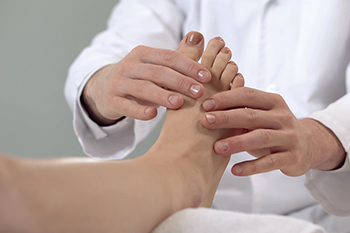
There are twenty six bones in the foot, and the heel bone is considered to be the largest one. Common causes of heel pain are overuse, and wearing shoes that do not fit correctly. These reasons can lead to painful conditions that can include plantar fasciitis, Achilles tendonitis, reactive arthritis, or heel spurs. Plantar fasciitis is an ailment that can occur when the tissue that runs along the sole of the foot becomes inflamed, which is known as the plantar fascia. It may be treated by using anti-inflammatory medications, or relief may possibly come from wearing custom-made orthotics. The Achilles tendon is found on the calf, and it connects the heel to the calf muscles. An Achilles tendon injury can lead to heel pain, and it can cause difficulty in walking. There are several types of arthritis, and reactive arthritis is triggered by an infection. It can appear in the joints of the body after the infection has been treated. Patients who develop a heel spur often confuse it with plantar fasciitis. The symptoms are similar, despite the fact that they are two different conditions. A bony growth on the heel is defined as a heel spur, and often needs medical treatment for proper healing. If you have any type of heel pain, it is strongly suggested that you are under the care of a podiatrist who can determine what the cause of your heel pain is, and offer correct treatment solutions.
Many people suffer from bouts of heel pain. For more information, contact one of our podiatrists of Advanced Foot & Ankle Medical Center . Our doctors can provide the care you need to keep you pain-free and on your feet.
Causes of Heel Pain
Heel pain is often associated with plantar fasciitis. The plantar fascia is a band of tissues that extends along the bottom of the foot. A rip or tear in this ligament can cause inflammation of the tissue.
Achilles tendonitis is another cause of heel pain. Inflammation of the Achilles tendon will cause pain from fractures and muscle tearing. Lack of flexibility is also another symptom.
Heel spurs are another cause of pain. When the tissues of the plantar fascia undergo a great deal of stress, it can lead to ligament separation from the heel bone, causing heel spurs.
Why Might Heel Pain Occur?
- Wearing ill-fitting shoes
- Wearing non-supportive shoes
- Weight change
- Excessive running
Treatments
Heel pain should be treated as soon as possible for immediate results. Keeping your feet in a stress-free environment will help. If you suffer from Achilles tendonitis or plantar fasciitis, applying ice will reduce the swelling. Stretching before an exercise like running will help the muscles. Using all these tips will help make heel pain a condition of the past.
If you have any questions please contact our office located in Thousand Oaks, CA . We offer the newest diagnostic and treatment technologies for all your foot and ankle needs.




